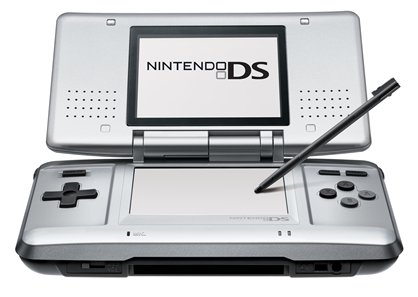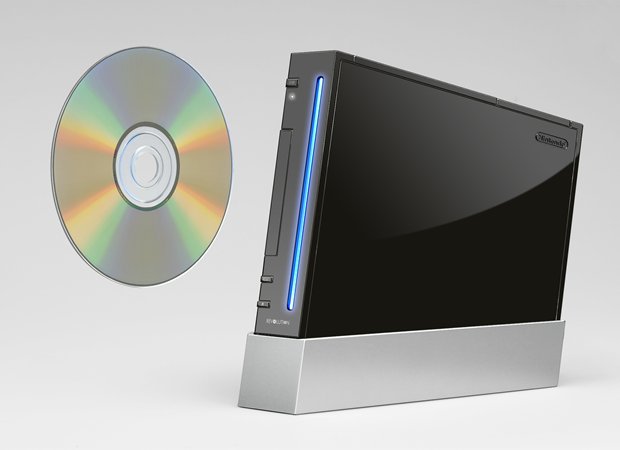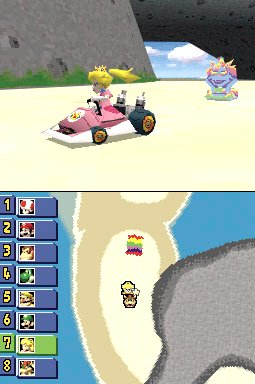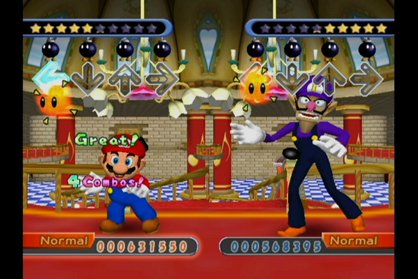Analogue sticks? D-pads? Buttons? Move over, grandad – 2004’s in da house. The foundations for the Wii were laid this year as Nintendo tired of the traditional gaming inputs they themselves had invented, and began looking for new ways to encourage non-gamers to play. In doing so, they turned their fortunes around dramatically in just a few short years. They had a few misfires before hitting the bullseye, however…

One of their boldest attempts – and certainly the most bizarre – was the DK Bongo peripheral, a couple of plastic barrels with a smashingly tactile rubber drumskin draped over the top, just ripe for the slapping. The drums were designed primarily for Namco’s rhythm-action series Donkey Konga (itself derived from the Japanese drum-spanking arcade game Taiko no Tatsujin), but even in these dark, pre-Guitar Hero days, Donkey Konga’s one-note game mechanics got a cool reception.
It took Nintendo EAD (who would go on to craft the similarly fantastic Super Mario Galaxy out of stardust and baby kittens) to unlock the bongos’ true potential with Donkey Kong: Jungle Beat. A 2D score-attack platform game controlled entirely by beating away on the drumskins, this contained more ideas in one small optical disc than the whole of Belguim.
Unorthodox control system #2 – waggle. Nintendo released Yoshi’s Universal Gravitation in Japan in December 2003, which featured a tilt sensor built into the game cartridge. Unfortunately, it was developed by Artoon. Unorthodox control system #3 – hooking four GBAs up to a GameCube and having an absolute blast. Pac-Man Vs was effectively just classic Pac-Man, which was old hat in 1994, let alone 2004. But by passing control of the ghosts over to human players, Nintendo breathed new life into the game with just a single stroke of their magic design brush.

All of the above control absurdities seemed boringly functional compared to the utterly bonkers Nintendo DS, which was slowly unveiled as the year wore on. It’s impossible to explain just how alien it seemed to our Friends finale-watching 2004 eyes. Two screens? Touch controls? Outrageous! You may as well add a flowerpot while you’re at it. The DS was something that almost every games critic misjudged, and misjudged badly. The general perception was that the higher-spec PSP was going to pound it into two dual piles of mush. It spelled the end of Nintendo, they said.
Sony was the company with the momentum ahead of the two rival consoles’ launch in late 2004 (although Europe, with crushing inevitability, had to wait until 2005). Sony’s CEO, Kaz Hirai, arrogantly stated that “PSP will elevate portable entertainment out of the handheld gaming ghetto.”
Compared to Sony, Nintendo seemed to lack confidence in their own product. It was stripped of the Game Boy name and distanced from the brand, and was referred to as a ‘third pillar’, an experimental halfway point between Cube and GBA. No one could possibly have predicted at this point that the DS would go on to easily outsell the GBA, itself a massive success. It’s still entirely feasible that it will go on to outsell the original Game Boy and the PlayStation 2, which would make it the best-selling console of all time. Not bad for a device which was supposed to sound Nintendo’s death knell.
Weekly digests, tales from the communities you love, and more

More news… Nintendo officially announced the existence of their forthcoming Revolution (later Wii) console, there was more first-party goodness with the likes of Pikmin 2 and Paper Mario: The Thousand Year Door, while the handheld plaudits went to the brilliantly inventive WarioWare, Inc., which we described as a “minigame tornado”. There’d be more of that on Revoluti… er, Wii.
2004 VERDICT: 7
Nintendo, stung by the under-performance of several key titles, eased off the pedal and concentrated on the hardware. A bit dull at the time, but a wise move.
2005
This year was dominated by one image: Nintendo president Satoru Iwata holding up the Revolution’s controller at the Tokyo Game Show in September. It was an iPod white, and looked more like a TV remote than a normal… wait a minute, why are we bothering to describe the Wii remote to you? Temporary insanity is the only excuse we’ve got that holds water.

The Revolution controller caused an immediate sensation as people tried to get their heads around how it would work. Iwata, however, was defiant. “Since the days of Famicom, the game control mechanism has become more and more sophisticated,” he commented during his TGS speech. “Perhaps those who have quit gaming or who have never played with games looked at the controller and felt it may be too difficult to play, even before they dared to touch it.” No one knew quite how it was going to pan out (we wouldn’t see any Revolution gameplay until mid-2006), but it was clear that the next-generation console race had just got verrrrry interesting.
Before all that kicked off though, the country was gripped by DS-mania. Well, that’s a bit of an exaggeration – the DS had a very quiet first year, but one that treated us to a number of quality touchy-feely games. The much-anticipated port of Super Mario 64 quickly established that 3D platforming wasn’t really the DS’ specialty, but its 2D counterparts flourished, with Castlevania: Dawn of Sorrow, Sonic Rush and the charmingly unique paint-’em-up Kirby: Canvas Curse (Power Paintbrush in the UK) all impressing us.

Elsewhere on DSwatch: Mario Kart DS hooked Nintendo’s bundle of double-trouble up to Wi-Fi for the first time, allowing players to enjoy lag-free four-player races – when people weren’t deliberately dropping out after falling two centimetres behind, that is. There was a hint of casual things to come with the eye-wateringly cute Nintendogs. But the ultimate DS game of 2005 came entirely from leftfield – the Japan-exclusive rhythm-action title Osu! Tatakae! Ouendan, in which a band of burly cheerleaders help unfortunates avoid personal ruin by tapping the screen in time with the music.
This year was, to all intents and purposes, the GBA’s swansong, although we did get one final redesign in the Game Boy Micro, which was so impossibly small we had to keep checking that ours hadn’t fallen through the stitching in our trouser pockets. We also got a final classic for the departing format in WarioWare: Twisted!, which used 2004’s tilt-sensor technology to somehow make the minigame Mardi Gras even madder. Unfortunately it wasn’t released in the UK for reasons that no one is quite sure of.
The GameCube’s year got off to an explosive start with Resident Evil 4, which completely reinvented the ailing RE series’ mechanics, in the process creating a horror game of incomparable drama. But things quickly went south for the format after that, and by the end of the year the Cube was pretty much dead. Third-party support had dried up into a husk of nothingness, and Nintendo’s big 2005 title, Legend of Zelda: Twilight Princess was delayed into 2006, which as we later discovered, was so it could be ported over in time for the Revolution’s launch.

Things were so desperate that Mario was reduced to making himself available to any second-rate game that wanted his bulbous body. He made shameful cameos in EA’s NBA Street V3 and SSX On Tour, as well as starring in a range of iffy spin-off titles, the nadir of which had to be Dance Dance Revolution Mario Mix. But it’s always darkest before dawn, and in 2006 the world began to wake up to Nintendo’s master plan.
2005 VERDICT: 6
Nintendo, marginalised by its bigger rivals, decided to tread a different path in 2005. Many observers predicted that Nintendo were a spent force, and mediocre early support for DS didn’t help their cause…


